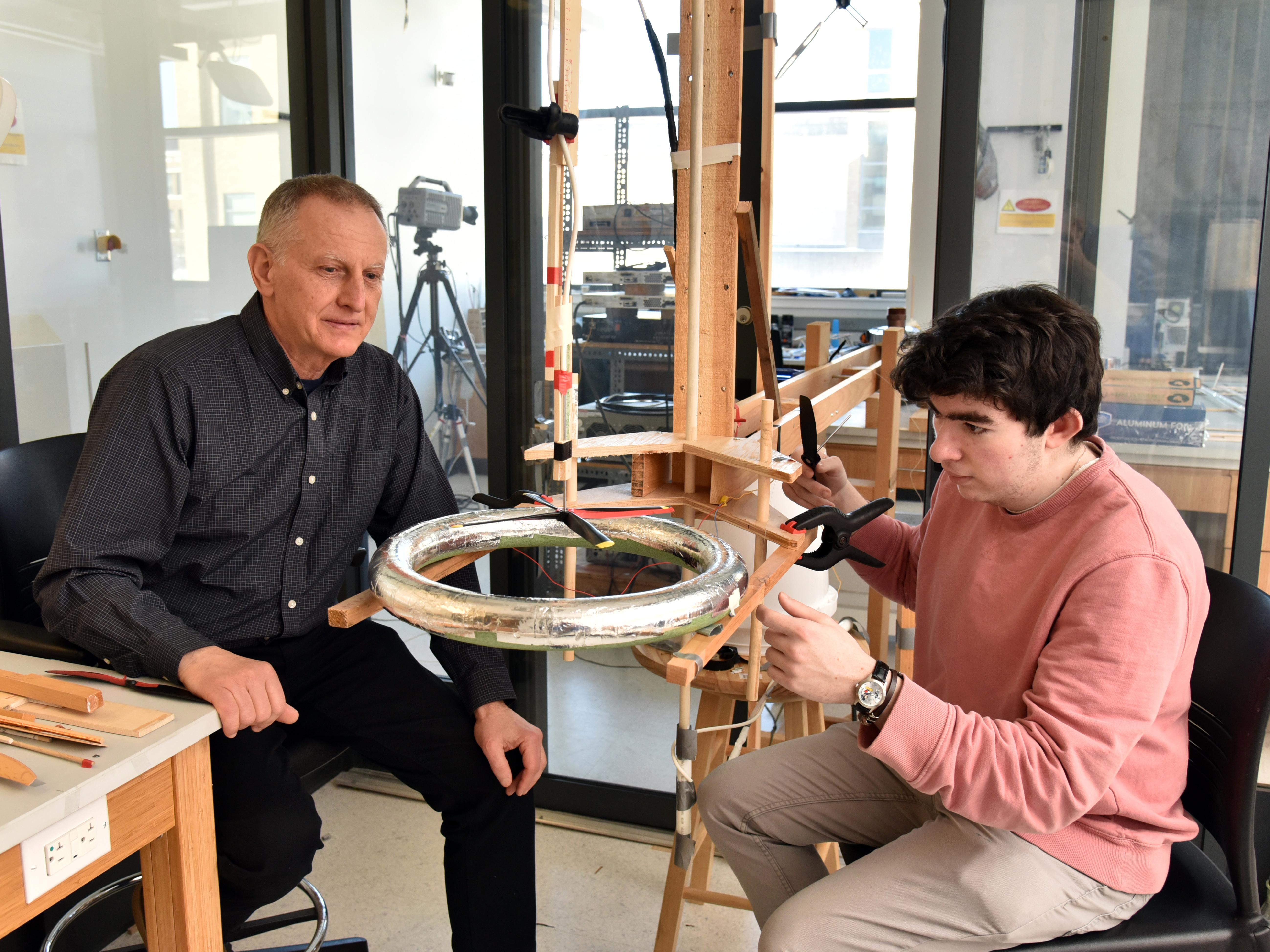Electrical and computer engineering professor Adrian Ieta (left) and student researcher Jack Gallagher look at the revolutionary ionic wind rotational propulsion system, which recently received a patent.
A propulsion technology breakthrough has resulted in a new patent for SUNY Oswego’s electrical and computer engineering professor Adrian Ieta’s ionic wind research.
In 2018, Ieta and a team of students achieved a first-of-its-kind flight with this new type of rotational propulsion system. Ionic wind uses electricity to power movement, as high voltage between asymmetrical electrodes generates an intense electric field near the sharp electrode and over a certain voltage leads to local ionization of the air.
“When using propellers equipped with ionic wind emitters, I was able to make them lift off and fly,” Ieta said. “The result was the first of its kind and would raise the question if ionic drones powered like this would be possible.”
Continuing experiments to enhance and control the induced rotational motion could lead to such offerings as ionic fans or ionic hoods that could use ions to destroy airborne microbes in a particular space.
“The ionic wind is sensitive to the composition of the air, and potentially ionic rotary sensors can be developed and be commercialized,” Ieta said. “There are all sorts of demo units that could be developed for academic use, or for hobbyists.”
Ion wind has been a known phenomenon for a while -- first reported in 1709 and with the first ionic wind rotational device in 1760 -- but nobody had succeeded in making an ionic wind-activated device spin and lift off in air until the breakthrough in a Shineman Center lab. Although some may say that the effect is expected, it was unknown whether it was possible at all, Ieta said.
Research and development
“In essence, the patent ensures priority for creating rotational devices using ionic wind,” Ieta explained. “The ionic wind emitters I produced include metal pins, metal tape and other conductive materials. Moreover, in order to intensify the electric field, and with it the ionic wind, I used an additional ground electrode around the emitters.”
While Ieta holds the patent, it has inspired other research and advancements, most notably with a colleague in Romania, Marius Chirita, of Romania’s National Institute for Research and Development in Electrochemistry and Condensed Matter.
Chirita “was fascinated by it and continued the research and enhanced the testing even in gases other than air,” Ieta said. They worked together during Ieta’s recent sabbatical and learned that atmospheres with higher oxygen concentrations enhanced the ability to produce ionic wind.
Most of the subsequent research involved small propeller models, but Ieta noted that larger propellers can bring enhanced efficiency and significantly more thrust. The next step is to get an ionic wind device with enough power to lift its own self-contained power supply.
Ieta first researched the topic around 25 years ago as an undergraduate before returning to the subject around 2011.
“The students liked it so I really wanted to go in that direction,” Ieta said. That led to the 2018 breakthrough and all the avenues it opened for research and development.
The work at Oswego continues to provide students with opportunities to investigate different configurations and create structures that ionic wind might be able to lift. Students presented some of their research at Quest last year, but experiments are ongoing.
“All the experiments involve different ways to use this technology and develop systems,” Ieta said. “This includes looking at ways to control the intensity and direction of the ionic wind.”
Ieta’s research continues to gain attention even before completing the lengthy patent process, with articles in two of the leading publications in the field, the Journal of Propulsion and Power as well as Propulsion and Power Research, as well as Nature’s Scientific Reports.
Even with this significant milestone, in a recent interview, Ieta expressed pride in the work of other colleagues in the Electrical and Computer Engineering Department that are leading to progress in a range of technologies.
“I think it’s really neat to have so much patent development going on in a relatively new engineering department,” he said.




